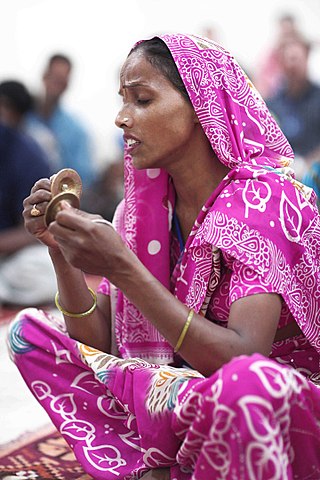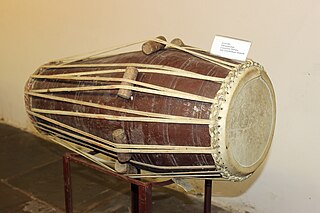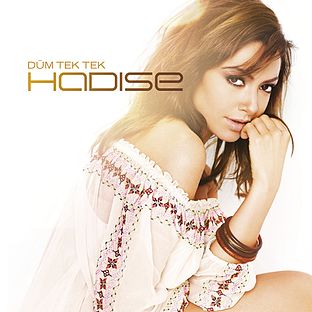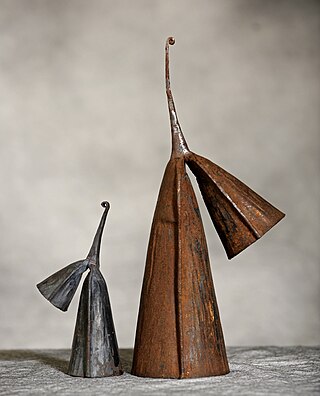Maqsoum (Egyptian slang: Maasoum) is a derivative form of the traditional Egyptian Baladi genre, an urban folk rhythmic style. The only difference is the accent on the second beat of maqsoum.
Maqsoum (Egyptian slang: Maasoum) is a derivative form of the traditional Egyptian Baladi genre, an urban folk rhythmic style. The only difference is the accent on the second beat of maqsoum.
The basic structure of the baladi rhythm, played on the darbuka, is as follows:
1 & 2 & 3 & 4 & D-D---T-D---T---
(Dum Dum ... Tek Dum ... Tek ...)
While the basic structure of the maqsoum rhythm, played on the same instrument, is as follows:
1 & 2 & 3 & 4 & D-T---T-D---T---
(Dum Tek ... Tek Dum ... Tek ...)
Where capital letters represent the stressed beats. Dum is the dominant hand on the middle of the tabla, Tek either the dominant or the non-dominant hand on the rim of the tabla.
Rhythm generally means a "movement marked by the regulated succession of strong and weak elements, or of opposite or different conditions". This general meaning of regular recurrence or pattern in time can apply to a wide variety of cyclical natural phenomena having a periodicity or frequency of anything from microseconds to several seconds ; to several minutes or hours, or, at the most extreme, even over many years.

In music performances, rhythm guitar is a technique and role that performs a combination of two functions: to provide all or part of the rhythmic pulse in conjunction with other instruments from the rhythm section ; and to provide all or part of the harmony, i.e. the chords from a song's chord progression, where a chord is a group of notes played together. Therefore, the basic technique of rhythm guitar is to hold down a series of chords with the fretting hand while strumming or fingerpicking rhythmically with the other hand. More developed rhythm techniques include arpeggios, damping, riffs, chord solos, and complex strums.

In music, metre or meter refers to regularly recurring patterns and accents such as bars and beats. Unlike rhythm, metric onsets are not necessarily sounded, but are nevertheless implied by the performer and expected by the listener.

The goblet drum is a single-head membranophone with a goblet-shaped body. It is most commonly used in the traditional music of Egypt, where it is considered the national symbol of Egyptian Shaabi Music. The instrument is also featured in traditional music from West Asia, North Africa, South Asia, and Eastern Europe. The West African djembe is also a goblet membranophone. This article focuses on the Middle Eastern and North African goblet drum.

In music and music theory, the beat is the basic unit of time, the pulse, of the mensural level. The beat is often defined as the rhythm listeners would tap their toes to when listening to a piece of music, or the numbers a musician counts while performing, though in practice this may be technically incorrect. In popular use, beat can refer to a variety of related concepts, including pulse, tempo, meter, specific rhythms, and groove.
Dumbek rhythms are a collection of rhythms that are usually played with hand drums such as the dumbek. These rhythms are various combinations of these three basic sounds:
Ektal or Ektaal is a tala in Indian music. It is commonly used in classical music like kheyal, and semi-classical forms like Rabindra Sangeet. In ektal the 12 matras are divided into 6 vibhags of two matras each. Ektal is played in Drut gatti. This tala is mostly played by the use of tabla. One more tala similar to Ektal is Chowtal which is played with the use of Pakhavaj,Ektaal is the tabla counterpart of Chowtaal. Many beautiful Kaida are played in Ektal. But Ektal is mostly played for Vilambit.

A tala literally means a 'clap, tapping one's hand on one's arm, a musical measure'. It is the term used in Indian classical music similar to musical meter, that is any rhythmic beat or strike that measures musical time. The measure is typically established by hand clapping, waving, touching fingers on thigh or the other hand, verbally, striking of small cymbals, or a percussion instrument in the Indian subcontinental traditions. Along with raga which forms the fabric of a melodic structure, the tala forms the life cycle and thereby constitutes one of the two foundational elements of Indian music.

Zills or zils, also called finger cymbals, are small metallic cymbals used in belly dancing and similar performances. They are called sāgāt in Egypt. They are similar to Tibetan tingsha bells. In Western music, several pairs can be set in a frame to make a tambourine.

The davul, dhol, tapan, atabal or tabl is a large double-headed drum that is played with mallets. It has many names depending on the country and region. These drums are commonly used in the music of the Middle East and the Balkans. These drums have both a deep bass sound and a thin treble sound due to their construction and playing style, where different heads and sticks are used to produce different sounds on the same drum.
In Ottoman classical music, usul is an underlying rhythmic cycle that complements the melodic rhythm and sometimes helps shape the overall structure of a composition. An usul can be as short as two beats or as long as 128 beats. Usul is often translated as "meter", but usul and meter are not exactly the same. Both are repeating rhythmic patterns with more or less complex inner structures of beats of differing duration and weight. But a student learning Turkish music in the traditional meşk system first memorizes the usul kinetically by striking the knees with the hands. The student then sings the vocal or instrumental composition while performing the underlying usul. This pedagogical system helps the student memorize the composition while internalizing the underlying rhythmic structure.

The pakhavaj is a barrel-shaped, two-headed drum, originating from the Indian subcontinent, the oldest version of double sided drums and its descendants are mridangam of Southern India and kendang of Maritime Southeast Asia and other South Asian double-headed drums. Its older forms were made with clay.
Baladi can refer to an Egyptian musical style, the folk style of Egyptian bellydance, or the Masmoudi Sogheir rhythm, which is frequently used in baladi music. It is also sometimes spelled in English as 'beledi' or 'baladee'.
In music, the term swing has two main uses. Colloquially, it is used to describe the propulsive quality or "feel" of a rhythm, especially when the music prompts a visceral response such as foot-tapping or head-nodding. This sense can also be called "groove".

"Düm Tek Tek" is a song by Belgian-Turkish singer Hadise with music composed by Sinan Akçıl and lyrics written by Akçıl, Hadise, and Stefan Fernande. It represented Turkey in the Eurovision Song Contest 2009 held in Moscow.

A tabla is a pair of hand drums from the Indian subcontinent. Since the 18th century, it has been the principal percussion instrument in Hindustani classical music, where it may be played solo, as an accompaniment with other instruments and vocals, or as a part of larger ensembles. It is frequently played in popular and folk music performances in India, Bangladesh, Afghanistan, Pakistan, Nepal and Sri Lanka. The tabla is an essential instrument in the bhakti devotional traditions of Hinduism and Sikhism, such as during bhajan and kirtan singing. It is one of the main qawwali instruments used by Sufi musicians. The instrument is also featured in dance performances such as Kathak. Tabla is a rhythmic instrument.

A bell pattern is a rhythmic pattern of striking a hand-held bell or other instrument of the idiophone family, to make it emit a sound at desired intervals. It is often a key pattern, in most cases it is a metal bell, such as an agogô, gankoqui, or cowbell, or a hollowed piece of wood, or wooden claves. In band music, bell patterns are also played on the metal shell of the timbales, and drum kit cymbals.
Hossam Ramzy was an Egyptian percussionist and composer. He worked with English artists including Jimmy Page and Robert Plant, Siouxsie Sioux, as well as with Arabic music artists like Rachid Taha and Khaled.
The Brothers of the Baladi is an American world music band based in Portland, Oregon. They play both traditional Middle Eastern music, and also combines traditional Middle Eastern and western sounds and instruments for a unique Worldbeat sound. Band leader/percussionist/vocalist Michael Beach provides lyrics in Arabic, Turkish, Persian, French, Spanish, Kurdish, Armenian and English, and the band features many traditional Middle Eastern instruments including oud, saz, mizmar, midjwiz, arghool, doumbek, riq, def, tar, bendir and davul.

Arab folk dances, also referred to as Oriental dance, Middle-Eastern dance and Eastern dance, are the traditional folk dances of the Arabs in Arab world. Arab dance has many different styles, including the three main types of folklore, classical, and contemporary. It is enjoyed and implemented throughout the Arab region, from North Africa to the Middle East.